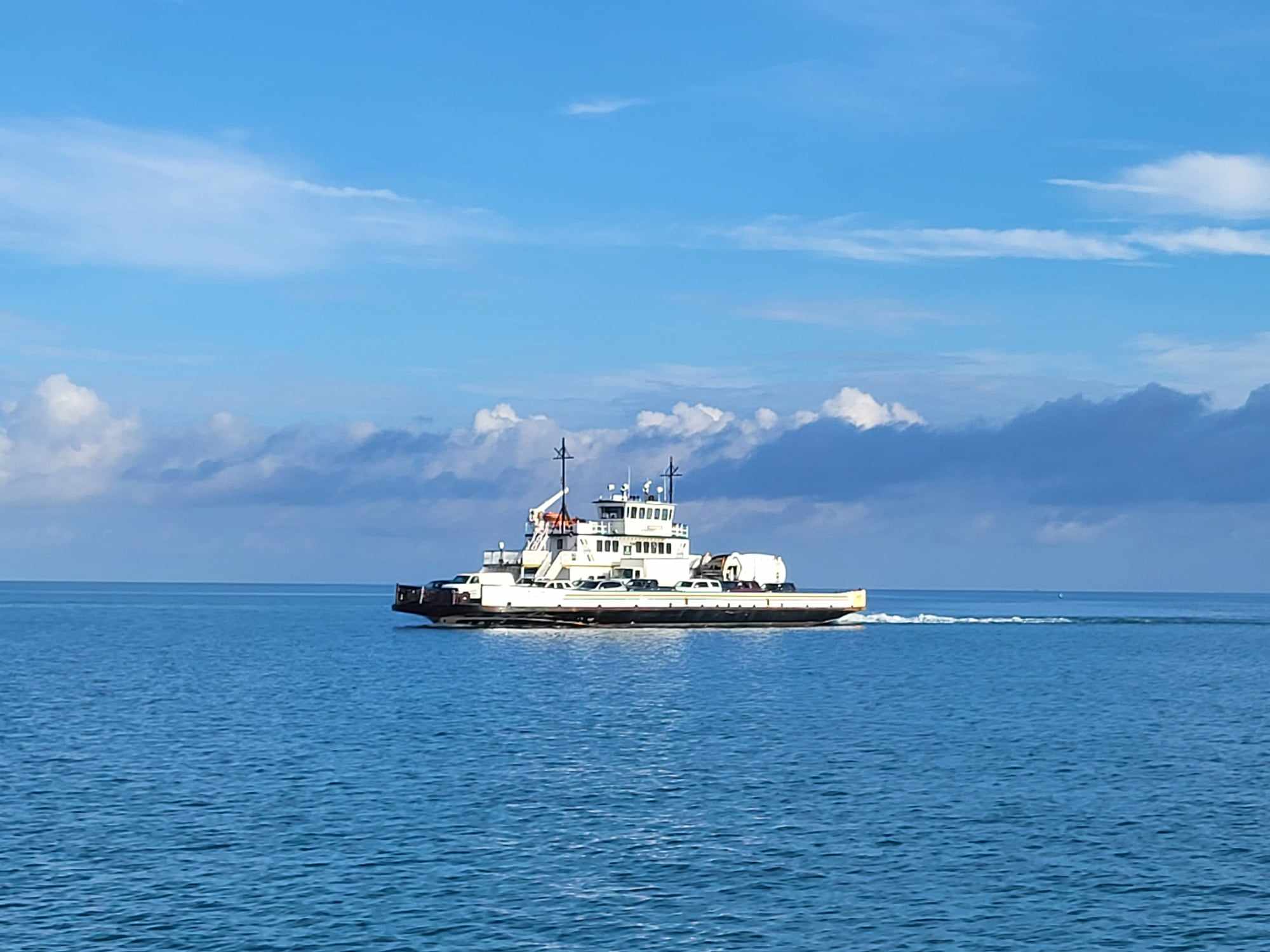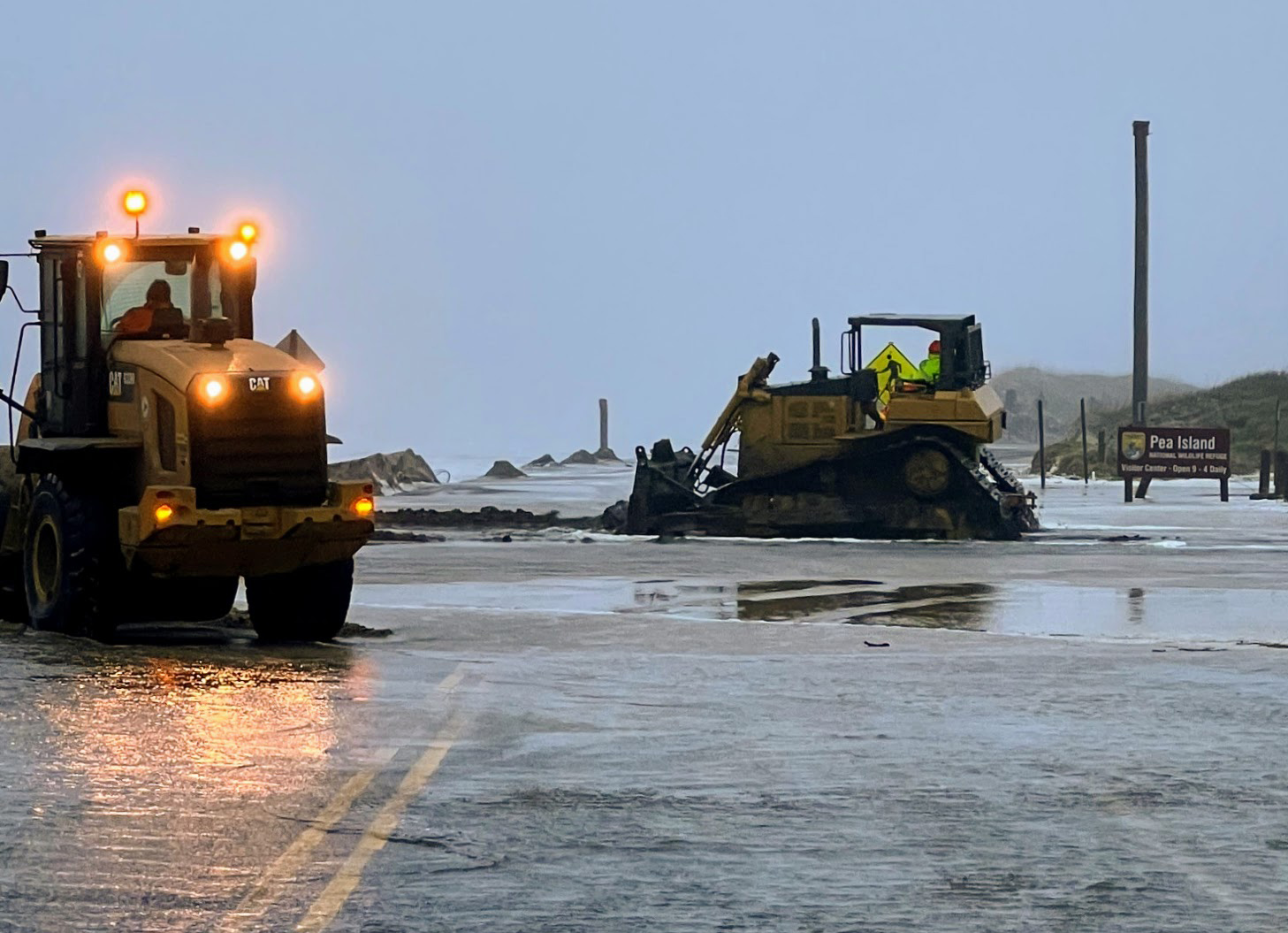FOR MORE INFORMATION On North Carolina wildfires: http://www.inciweb.org/state/34/ On the Dismal Swamp wildfire in southeastern Virginia: http://www.inciweb.org/incident/2458/
North Carolina wildfire situation improving, but new fire erupts in Dismal Swamp
By IRENE NOLAN
By IRENE NOLAN
By IRENE NOLAN
The Pains Bay wildfire in Alligator River National Wildlife Refuge on the Dare County mainland is steadily coming under control.
The fire is considered 100 percent contained, but smoke and flames were still erupting from smoldering fires in underground peat deposits with a flare-up as recently as July 29.
Over the past weekend, the Pains Bay Fire received rain, ranging from one to two inches, depending on the location, according to a media release this week from the U.S. Fish and Wildlife Service.
An aerial flight on Sunday, Aug. 7, showed no visible smoke coming from the fire, which was first reported on May 5 and was probably caused by lightning.
Though eastern North Carolina continues to suffer from serious drought conditions overall, the recent rain provided temporary relief for local firefighters.
“It was great to have some rain, but with the drought severity in this part of the state, we will continue to have flare-ups whenever we have drier, windy days,” explained District Fire Management Officer Tom Crews.
That was the good news, but the not-so-good news is that a new wildfire was reported on Aug. 4 in the Dismal Swamp area of southeastern Virginia.
That fire, also thought to have been caused by lightning, was first reported on Thursday, Aug. 4.
Yesterday afternoon, it was burning over 4,700 acres and was only 10 percent contained.
Heavy smoke from that fire was blowing into the Hampton Roads area and also affected the northern Outer Banks over the weekend and early this week.
Yesterday, Wednesday, there was a smoky odor on Hatteras for the first time in about a month. With a wind shift, it apparently came from the Dismal Swamp fire, called the Lateral West Fire.
In May and June, Hatteras and Ocracoke were periodically affected by heavy smoke and ash from the Pains Bay fire and then from wildfires fires in southeastern North Carolina.
There has been little or no smoke on the islands since the July 4 weekend.
The Pains Bay fire has burned 45,000 acres and threatened the mainland fishing community of Stumpy Point.
There is still some ground fire, perhaps as much as 1,000 acres, in the area.
The Juniper Road fire in Pender County in southeast North Carolina has burned 31,140 acres and is 92 percent contained. It was reported on June 19 and was started by lightning.
The Pains Bay wildfire in Alligator River National Wildlife Refuge on the Dare County mainland is steadily coming under control.
The fire is considered 100 percent contained, but smoke and flames were still erupting from smoldering fires in underground peat deposits with a flare-up as recently as July 29.
Over the past weekend, the Pains Bay Fire received rain, ranging from one to two inches, depending on the location, according to a media release this week from the U.S. Fish and Wildlife Service.
An aerial flight on Sunday, Aug. 7, showed no visible smoke coming from the fire, which was first reported on May 5 and was probably caused by lightning.
Though eastern North Carolina continues to suffer from serious drought conditions overall, the recent rain provided temporary relief for local firefighters.
“It was great to have some rain, but with the drought severity in this part of the state, we will continue to have flare-ups whenever we have drier, windy days,” explained District Fire Management Officer Tom Crews.
That was the good news, but the not-so-good news is that a new wildfire was reported on Aug. 4 in the Dismal Swamp area of southeastern Virginia.
That fire, also thought to have been caused by lightning, was first reported on Thursday, Aug. 4.
Yesterday afternoon, it was burning over 4,700 acres and was only 10 percent contained.
Heavy smoke from that fire was blowing into the Hampton Roads area and also affected the northern Outer Banks over the weekend and early this week.
Yesterday, Wednesday, there was a smoky odor on Hatteras for the first time in about a month. With a wind shift, it apparently came from the Dismal Swamp fire, called the Lateral West Fire.
In May and June, Hatteras and Ocracoke were periodically affected by heavy smoke and ash from the Pains Bay fire and then from wildfires fires in southeastern North Carolina.
There has been little or no smoke on the islands since the July 4 weekend.
The Pains Bay fire has burned 45,000 acres and threatened the mainland fishing community of Stumpy Point.
There is still some ground fire, perhaps as much as 1,000 acres, in the area.
The Juniper Road fire in Pender County in southeast North Carolina has burned 31,140 acres and is 92 percent contained. It was reported on June 19 and was started by lightning.
The Pains Bay wildfire in Alligator River National Wildlife Refuge on the Dare County mainland is steadily coming under control.
The fire is considered 100 percent contained, but smoke and flames were still erupting from smoldering fires in underground peat deposits with a flare-up as recently as July 29.
Over the past weekend, the Pains Bay Fire received rain, ranging from one to two inches, depending on the location, according to a media release this week from the U.S. Fish and Wildlife Service.
An aerial flight on Sunday, Aug. 7, showed no visible smoke coming from the fire, which was first reported on May 5 and was probably caused by lightning.
Though eastern North Carolina continues to suffer from serious drought conditions overall, the recent rain provided temporary relief for local firefighters.
“It was great to have some rain, but with the drought severity in this part of the state, we will continue to have flare-ups whenever we have drier, windy days,” explained District Fire Management Officer Tom Crews.
That was the good news, but the not-so-good news is that a new wildfire was reported on Aug. 4 in the Dismal Swamp area of southeastern Virginia.
That fire, also thought to have been caused by lightning, was first reported on Thursday, Aug. 4.
Yesterday afternoon, it was burning over 4,700 acres and was only 10 percent contained.
Heavy smoke from that fire was blowing into the Hampton Roads area and also affected the northern Outer Banks over the weekend and early this week.
Yesterday, Wednesday, there was a smoky odor on Hatteras for the first time in about a month. With a wind shift, it apparently came from the Dismal Swamp fire, called the Lateral West Fire.
In May and June, Hatteras and Ocracoke were periodically affected by heavy smoke and ash from the Pains Bay fire and then from wildfires fires in southeastern North Carolina.
There has been little or no smoke on the islands since the July 4 weekend.
The Pains Bay fire has burned 45,000 acres and threatened the mainland fishing community of Stumpy Point.
There is still some ground fire, perhaps as much as 1,000 acres, in the area.
The Juniper Road fire in Pender County in southeast North Carolina has burned 31,140 acres and is 92 percent contained. It was reported on June 19 and was started by lightning.
The Pains Bay wildfire in Alligator River National Wildlife Refuge on the Dare County mainland is steadily coming under control.
The fire is considered 100 percent contained, but smoke and flames were still erupting from smoldering fires in underground peat deposits with a flare-up as recently as July 29.
Over the past weekend, the Pains Bay Fire received rain, ranging from one to two inches, depending on the location, according to a media release this week from the U.S. Fish and Wildlife Service.
An aerial flight on Sunday, Aug. 7, showed no visible smoke coming from the fire, which was first reported on May 5 and was probably caused by lightning.
Though eastern North Carolina continues to suffer from serious drought conditions overall, the recent rain provided temporary relief for local firefighters.
“It was great to have some rain, but with the drought severity in this part of the state, we will continue to have flare-ups whenever we have drier, windy days,” explained District Fire Management Officer Tom Crews.
That was the good news, but the not-so-good news is that a new wildfire was reported on Aug. 4 in the Dismal Swamp area of southeastern Virginia.
That fire, also thought to have been caused by lightning, was first reported on Thursday, Aug. 4.
Yesterday afternoon, it was burning over 4,700 acres and was only 10 percent contained.
Heavy smoke from that fire was blowing into the Hampton Roads area and also affected the northern Outer Banks over the weekend and early this week.
Yesterday, Wednesday, there was a smoky odor on Hatteras for the first time in about a month. With a wind shift, it apparently came from the Dismal Swamp fire, called the Lateral West Fire.
In May and June, Hatteras and Ocracoke were periodically affected by heavy smoke and ash from the Pains Bay fire and then from wildfires fires in southeastern North Carolina.
There has been little or no smoke on the islands since the July 4 weekend.
The Pains Bay fire has burned 45,000 acres and threatened the mainland fishing community of Stumpy Point.
There is still some ground fire, perhaps as much as 1,000 acres, in the area.
The Juniper Road fire in Pender County in southeast North Carolina has burned 31,140 acres and is 92 percent contained. It was reported on June 19 and was started by lightning.
The Simmons Road fire in nearby Bladen and Cumberland counties has burned 4,438 acres and is 95 percent contained. It was reported on June 20 and was also caused by lightning.
The Simmons Road fire in nearby Bladen and Cumberland counties has burned 4,438 acres and is 95 percent contained. It was reported on June 20 and was also caused by lightning.
The Simmons Road fire in nearby Bladen and Cumberland counties has burned 4,438 acres and is 95 percent contained. It was reported on June 20 and was also caused by lightning.
The Simmons Road fire in nearby Bladen and Cumberland counties has burned 4,438 acres and is 95 percent contained. It was reported on June 20 and was also caused by lightning.
FOR MORE INFORMATION
On North Carolina wildfires: http://www.inciweb.org/state/34/
On the Dismal Swamp wildfire in southeastern Virginia: http://www.inciweb.org/incident/2458/
FOR MORE INFORMATION
On North Carolina wildfires: http://www.inciweb.org/state/34/
On the Dismal Swamp wildfire in southeastern Virginia: http://www.inciweb.org/incident/2458/
FOR MORE INFORMATION
On North Carolina wildfires: http://www.inciweb.org/state/34/
On the Dismal Swamp wildfire in southeastern Virginia: http://www.inciweb.org/incident/2458/
FOR MORE INFORMATION
On North Carolina wildfires: http://www.inciweb.org/state/34/
On the Dismal Swamp wildfire in southeastern Virginia: http://www.inciweb.org/incident/2458/
Subject
Name
(required, will not be published)
(required, will not be published)
City :
State :
Your Comments:
May be posted on the Letters to the Editor page at the discretion of the editor.
May be posted on the Letters to the Editor page at the discretion of the editor.
May be posted on the Letters to the Editor page at the discretion of the editor.
May be posted on the Letters to the Editor page at the discretion of the editor.













